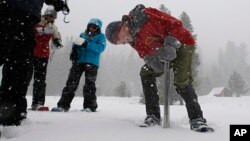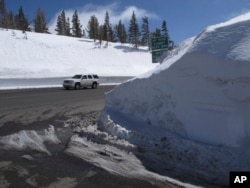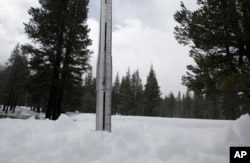As big snowflakes fell high in California's Sierra Nevada on Thursday, surveyors on snowshoes measured the deepest springtime snowpack in years and said it boosted concerns about destructive floods when all that snow melts.
Snow in the Sierra Nevada begins melting this time of year as the weather warms, and California is already waterlogged after storms slammed the state in January and February, flooding communities and washing out roads.
If more stormy weather hits the state and its mountains soon, snowmelt could speed up, putting pressure on reservoirs, some already brimming full and spilling over, officials said.
"It's something that we pay very close attention to," said Frank Gehrke, chief of the California Cooperative Snow Surveys Program, who led a small crew of surveyors into a snowy meadow surrounded by pine trees. "It's going to depend on how the spring plays out."
The Sierra snowpack's overall water content measured 164 percent of normal Wednesday, according to the state's electronic monitors throughout the mountain range.
It was even higher at Phillips Station near Lake Tahoe, where Gehrke's manual measurement — plunging a rod into the snow nearly 8 feet deep (2.5 meters) — showed its water-content at 183 percent of normal.
Snowdrifts are up to 20 feet (6 meters) deep at higher elevations in the central and southern parts of the range, he said.
The snowpack stretches along 400 miles (644 kilometers) of the Sierra Nevada, creating an icy reservoir that provides roughly one-third of irrigation and drinking water to the nation's most populous state during hot, dry months of the year.
Quite a contrast
The deep snowdrifts today contrast with the situation two years ago at the height of California's five-year drought, when Governor Jerry Brown traveled with surveyors to the same spot and there was no measurable snow.
He later ordered residents to use less water at home — a first for California. Hundreds of domestic wells ran dry during the drought. Many were in rural farming communities and some Californians were forced to drink bottled water and bathe from buckets.
Some farmers in the state that leads the nation in producing fruits, vegetables and nuts drew down wells to grow their crops, while others left fields unplanted.
Drought eased last winter, and monster storms in recent months have put a major dent in the five-year drought.
It's unclear whether the governor will lift his emergency drought declaration, which remains in place despite heavy storms. Brown could decide in April, Gehrke said.
This snowpack is the densest with water since 2011, the year before extreme drought hit California, said Doug Carlson, a spokesman for the California Department of Water Resources.
"When the history of this winter's wet season is written, undoubtedly it'll make note of the fact that this is a wet season that helped alleviate much of the drought," Carlson said.












